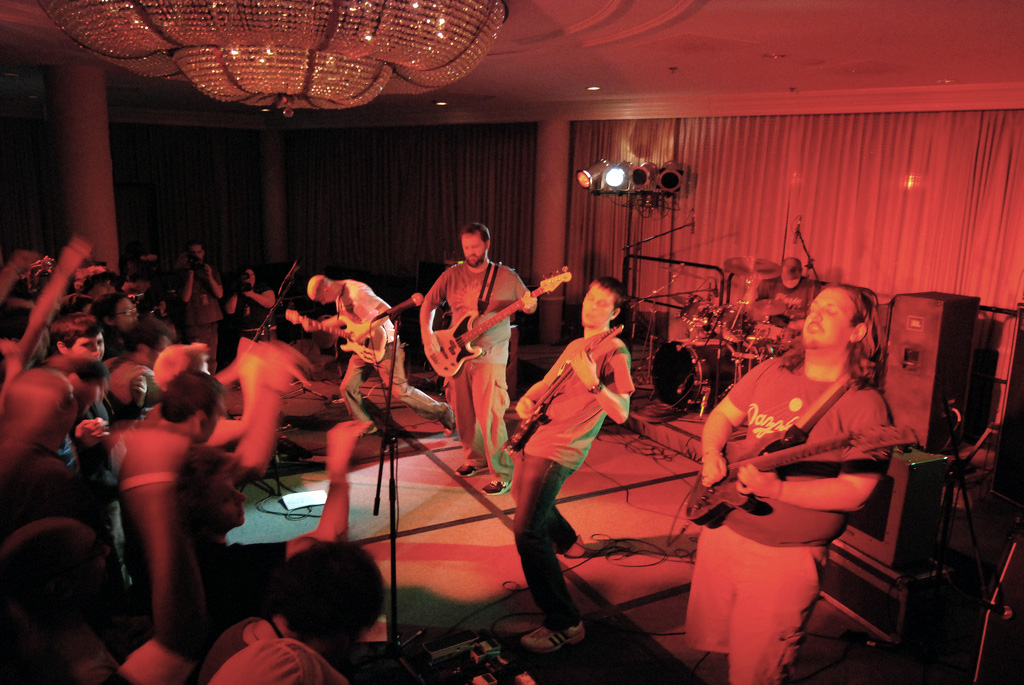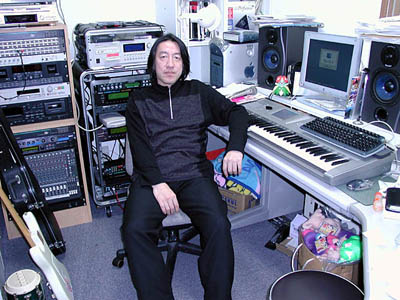
|
The Monkees, motorcycle-riding and Mike Tyson’s Punch-Out!!— though this hodgepodge of ideas might seem completely unrelated, it’s got all its roots (or branches) in Nintendo’s premier space-exploring, alien-hunting franchise not involving anthropomorphic creatures named “Fox” or “Slippy”. The music of Metroid may not be known for its happy-tastic melodies and sharp singable tunes, unlike certain other Nintendo games featuring plumbers or elven warriors, but it nevertheless has its own distinct flavor. It’s the difference between television commercial jingles and film orchestral scores– Metroid‘s music goes for something completely different, and doesn’t care what anyone thinks. So it’s interesting to note that while Samus Aran’s bounty hunting adventures definitely made their mark in Nintendo’s pantheon of video game legends (at least outside Japan, whose notoriously nonplussed nature when it comes to Metroid has not gone unnoticed), the music that frames all the action has often gone completely off the radar– at least, most of the time, as Stemage’s outstanding Metroid Metal series (above), a heavy metal interpretation of the Metroid soundtrack, can attest to. In fact, for a series that turns heads because of its independence from other Nintendo titles, the music of Metroid seems to do the exact opposite. Here at Nintendojo, neglecting any part of any series is definitely criminal– so let’s talk Metroid music.
Hirokazu “Hip” Tanaka

Long before gamers declared such figures as Jack Thompson and Roger Ebert obstacles in the quest for video game recognition in the mainstream, Hirokazu “Hip” Tanaka, 53, fought that battle in the only way he could– through music. Music, after all, had been a fixture in Mr. Tanaka’s life for some time– when it aired on Japanese television, the television show The Monkees found a devout audience member in Mr. Tanaka, then age nine. In fact, The Monkees kick-started a musical interest in Mr. Tanaka that caused him to form a band– a habit that lasted until he was 30. Though now the president of Creatures, Inc., Mr. Tanaka was initially one of Nintendo’s first sound engineers, designing sounds for games like Space Firebird (1980), an arcade shooter that foreshadowed Mr. Tanaka’s future success with the similarly galactic Metroid (1986), and one of the first to see game music as essential to a game’s character. In an interview with Gamasutra, Mr. Tanaka discussed this in detail:
The sound for games used be regarded just as an effect, but I think it was around the time Metroid was in development when the sound started gaining more respect and began to be properly called game music. Even the media had put spotlights on it, and we began to see many articles on game music.
Then, sound designers in many studios started to compete with each other by creating upbeat melodies for game music. The pop-like, lilting tunes were everywhere.
The industry was delighted, but on the contrary, I wasn’t happy with the trend, because those melodies weren’t necessarily matched with the tastes and atmospheres that the games originally had.
Ending – Metroid
Thus, after composing the music for Nintendo’s Kid Icarus, Nintendo assigned Mr. Tanaka to compose for Metroid, the premise of which would cause the composer to forgo any “pop-like, lilting tunes”, like those he would later arrange in Tetris (1989) or compose in EarthBound (1994). Instead, he’d create the eerie, almost chilling, atmospheric music that the Metroid series would become known for. Anyone who played the resulting game could instantly tell the difference between Hirokazu Tanaka’s Metroid score and, say, Koji Kondo’s Super Mario Bros. (1985) soundtrack– even if that difference was that they couldn’t tell whether or not Metroid had any music. In fact, gamers who ended up giving up before the end of Metroid not only failed to discover whether or not Samus Aran was actually a cyborg– they also missed out on the actual theme of Metroid, which Mr. Tanaka conscientiously objected to include until the very end of the game:
As you know, the melody in Metroid is only used at the ending after you killed the Mother Brain. That’s because I wanted only a winner to have a catharsis at the maximum level. For the reason, I decided that melodies would be eliminated during the gameplay. By melody here I mean something that someone can sing or hum.
After seeing this level of artistic enterprise, it’s almost unsurprising that Mr. Tanaka’s ideas snuck into areas of Metroid that seemingly had nothing to do with music. In fact, Mr. Tanaka personally named, at his own insistence, all the maps involved in Metroid, as well as “certain graphical concepts” involved therein; in Mr. Tanaka’s own words, Gunpei Yokoi, at the time Metroid‘s producer, “let [the team] have a very free working environment.”
For whatever reason, Mr. Tanaka never composed another song for a Metroid game, though his songs for games like Dr. Mario (1990) and Fire Emblem (1990) certainly remain memorable. Mr. Tanaka’s latest works can be found, along with many other composers’, in Super Smash Bros. Brawl (2008), where he arranged “75m” from Donkey Kong (1980) and “Squeak Squad Theme” from Kirby: Squeak Squad (2006) (known in Europe as Kirby: Mouse Attack).
Ryoji Yoshitomi
Ending – Metroid II: Return of Samus
After Hirokazu “Hip” Tanaka composed Metroid‘s groundbreaking soundtrack, Ryoji Yoshitomi stepped up to compose Metroid II: Return of Samus‘s (1991) blips and beeps. Mr. Yoshitomi’s efforts followed those of Mr. Tanaka’s, continuing to ignore the blatant melodies of other games and rather continue with a more minimalist approach. Like Metroid, Metroid II: Return of Samus featured nearly no discernible melodies until the very end of the game, where Mr. Yoshitomi sent players off with a soaring 8-bit overture (above). However, Ryoji Yoshitomi, like his predecessor, left the Metroid series after Metroid II: Return of Samus, working on games like Mario Paint (1992) and the WarioWare, Inc. (2003) series instead. The flowering Metroid series was left without a composer.
Kenji Yamamoto
Directed by Yoshio Sakamoto and designed by Sakamoto, Gunpei Yokoi, and Makoto Kano, Super Metroid (1994), being the console successor after a nearly decade-long wait to the 1986 Metroid, seemed set to reinvigorate the series, reinventing itself, just as Mario and Zelda did, for the 16-bit generation. And in fact, when players inserted their Super Metroid cartridges into their Super Nintendo Entertainment Systems, all ready to start up a new game, they were struck by only the first of many surprises– an actual voice clip from a disembodied, almost alien voice:
The last Metroid is in captivity. The galaxy is at peace.
Theme of Super Metroid – Super Metroid
 Now here was a sentence that would reverberate in gamers’ minds for years to come. (Though it’s probably better that Super Metroid didn’t include any more voice acting, considering the let’s-pretend-it’s-on-purpose nature of the prior sentence’s.) And after this sentence began a just-as-memorable soundtrack by Kenji Yamamoto, who would become the composer most associated with the Metroid series– indeed, unlike Hirokazu “Hip” Tanaka or Ryoji Yoshitomi, Kenji Yamamoto not only worked on Super Metroid, but also every other Metroid game afterward, whether in a composing or sound designing capacity, as he was with Metroid Prime Hunters (2004).
Now here was a sentence that would reverberate in gamers’ minds for years to come. (Though it’s probably better that Super Metroid didn’t include any more voice acting, considering the let’s-pretend-it’s-on-purpose nature of the prior sentence’s.) And after this sentence began a just-as-memorable soundtrack by Kenji Yamamoto, who would become the composer most associated with the Metroid series– indeed, unlike Hirokazu “Hip” Tanaka or Ryoji Yoshitomi, Kenji Yamamoto not only worked on Super Metroid, but also every other Metroid game afterward, whether in a composing or sound designing capacity, as he was with Metroid Prime Hunters (2004).
But Mr. Yamamoto’s first Metroid work, Super Metroid, the game from which Retro Studios and Nintendo R&D1 had to follow with Metroid Prime (2002) and Metroid Fusion (2002), respectively, still stands out. Though following in Mr. Tanaka’s and Mr. Yoshitomi’s ambience-focused footsteps, Mr. Yamamoto utilized the newly improved sound system of the Super Nintendo to create an even more cinematic score than before– an interesting effort, especially considering Mr. Yamamoto, whose only works prior to Super Metroid included Mike Tyson’s Punch Out!! (1987) and the obscure Famicom Detective Club (1988), says he came up with some pieces by singing them while motorcycling.
However, this by no means indicates Mr. Yamamoto’s tracks are, to Mr. Tanaka’s chagrin, actually hummable– though Mr. Yamamoto’s pieces clearly seem more melodic than Mr. Tanaka’s and Mr. Yoshimoto’s, they’re nevertheless more atmospheric than anything else. Tracks such as “Crateria – The Space Pirates Appear” and “Norfair Hot Lava Area” even involve chanting in the background, whereas tracks like “Theme of Samus Aran – Galactic Warrior” slowly build in intensity until a final, cathartic finish. In “Ending”, Mr. Yamamoto composes a piece that goes full circle to the beginning track, “Opening (Destruction of the Space Colony)”– a creation that signifies as much the rebirth of Samus’s world as it does the Metroid series. And though Mr. Yamamoto may have followed the general guidelines that his predecessors laid out, he nevertheless followed more his own path– creating complex polyphonic tunes (if not hummable melodies) over all of Mr. Tanaka and Mr. Yoshitomi’s blips, thus creating a wholly original soundtrack of Super Metroid instead of merely a tribute to Metroid and Metroid II: Return of Samus.
Arguably, Mr. Yamamoto’s steps forward mark some of the biggest changes in the Metroid series– after all, the gameplay of Metroid Prime certainly rocked Samus Aran’s world, but the music in Metroid Prime, also an incredibly cinematic experience, has its roots in Yamamoto’s Super Metroid soundtrack. Scott Petersen, of Retro Studios’s sound team, had this to say about Metroid Prime in this interview from Original Sound Version:
The game really hit all the right notes from every discipline. This is especially amazing when you consider that in Prime 1, all the sound effects for a world had to fit inside of 6 MB! (This includes all of the player package, creature and world sounds). I think this limitation had a huge part in making Prime 1 sound as good as it does; every sound had to hold its own weight for its inclusion in the game. We were also very lucky to have been able to use Yamamoto-san for the music as it was his work in Super Metroid that evolved and refined the themes Tanaka-san had established in the original Metroid. Together, the hyper-refined sound design and Yamamoto-san’s distinctive musical style really cemented the audio style and quality of Metroid Prime.
Kenji Yamamoto, in fact, continued to establish his gift for taking the old and making it new, with the following scores for each Metroid Prime game bearing his compositions. Though Metroid: Other M (2010) does not bear Mr. Yamamoto’s compositions, instead betting on the veteran anime and film composer Kuniaki Haishima (Blue Gender, Macross Zero), Mr. Yamamoto’s working with Retro Studios yet again on Donkey Kong Country Returns (November 2010), a perfect fit for his abilities to bring familiar themes into a new, contemporary medium. Whether or not they’ll be composed while Mr. Yamamoto was riding his motorbike, we’ll (probably) never know.




 ShareThis
ShareThis







